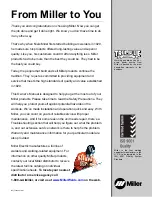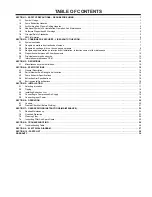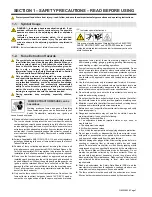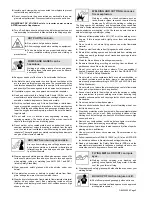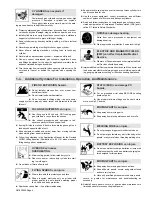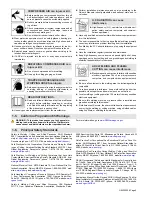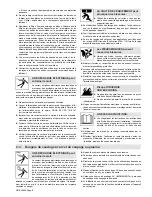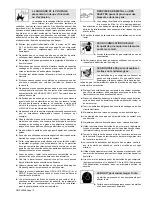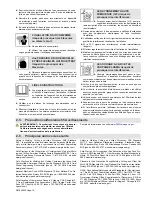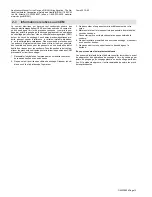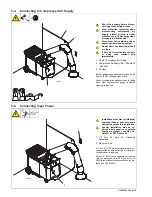
OM-239026 Page 4
CYLINDERS can explode if
damaged.
Compressed gas cylinders contain gas under high
pressure. If damaged, a cylinder can explode.
Since gas cylinders are normally part of the weld-
ing process, be sure to treat them carefully.
�
Protect compressed gas cylinders from excessive heat, mechani-
cal shocks, physical damage, slag, open flames, sparks, and arcs.
�
Install cylinders in an upright position by securing to a stationary
support or cylinder rack to prevent falling or tipping.
�
Keep cylinders away from any welding, cutting, or other electrical
circuits.
�
Never drape a welding or cutting torch over a gas cylinder.
�
Never allow a welding electrode or cutting torch to touch any
cylinder.
�
Never weld on a pressurized cylinder — explosion will result.
�
Use only correct compressed gas cylinders, regulators, hoses,
and fittings designed for the specific application; maintain them
and associated parts in good condition.
�
Turn face away from valve outlet when opening cylinder valve. Do
not stand in front of or behind the regulator when opening the
valve.
�
Keep protective cap in place over valve except when cylinder is in
use or connected for use.
�
Use the proper equipment, correct procedures, and sufficient
number of persons to lift, move, and transport cylinders.
�
Read and follow instructions on compressed gas cylinders, asso-
ciated equipment, and Compressed Gas Association (CGA) publi-
cation P-1 listed in Safety Standards.
NOISE can damage hearing.
Noise from some processes or equipment can
damage hearing.
�
Wear approved ear protection if noise level is high.
ELECTRIC AND MAGNETIC FIELDS
(EMF) can affect Implanted Medical
Devices.
�
Wearers of Pacemakers and other Implanted Med-
ical Devices should keep away.
�
Implanted Medical Device wearers should consult their doctor and
the device manufacturer before going near arc welding, spot weld-
ing, gouging, plasma arc cutting, or induction heating operations.
1-4.
Additional Symbols For Installation, Operation, And Maintenance
FIRE OR EXPLOSION hazard.
�
Do not install or place unit on, over, or near com-
bustible surfaces.
�
Do not install unit near flammables.
�
Do not overload building wiring — be sure power
supply system is properly sized, rated, and protected to handle
this unit.
FALLING EQUIPMENT can injure.
�
Use lifting eye to lift unit only, NOT running gear,
gas cylinders, or any other accessories.
�
Use correct procedures and equipment of ad-
equate capacity to lift and support unit.
�
If using lift forks to move unit, be sure forks are long enough to ex-
tend beyond opposite side of unit.
�
Keep equipment (cables and cords) away from moving vehicles
when working from an aerial location.
�
Follow the guidelines in the Applications Manual for the Revised
NIOSH Lifting Equation (Publication No. 94-110) when manually
lifting heavy parts or equipment.
OVERUSE can cause
OVERHEATING.
�
Allow cooling period; follow rated duty cycle.
�
Reduce current or reduce duty cycle before start-
ing to weld again.
�
Do not block or filter airflow to unit.
FLYING SPARKS can injure.
�
Wear a face shield to protect eyes and face.
�
Shape tungsten electrode only on grinder with
proper guards in a safe location wearing proper
face, hand, and body protection.
�
Sparks can cause fires — keep flammables away.
STATIC (ESD) can damage PC
boards.
�
Put on grounded wrist strap BEFORE handling
boards or parts.
�
Use proper static-proof bags and boxes to store,
move, or ship PC boards.
MOVING PARTS can injure.
�
Keep away from moving parts.
�
Keep away from pinch points such as drive rolls.
WELDING WIRE can injure.
�
Do not press gun trigger until instructed to do so.
�
Do not point gun toward any part of the body, other
people, or any metal when threading welding wire.
BATTERY EXPLOSION can injure.
�
Do not use welder to charge batteries or jump start
vehicles unless the unit has a battery charging fea-
ture designed for this purpose.
MOVING PARTS can injure.
�
Keep away from moving parts such as fans.
�
Keep all doors, panels, covers, and guards closed
and securely in place.
�
Have only qualified persons remove doors, panels,
covers, or guards for maintenance and troubleshooting as
necessary.
�
Reinstall doors, panels, covers, or guards when maintenance is
finished and before reconnecting input power.
Summary of Contents for FILTAIR
Page 4: ......
Page 18: ......
Page 37: ...Notes Visit www youtube com MillerWelders for informational videos ...
Page 39: ......


